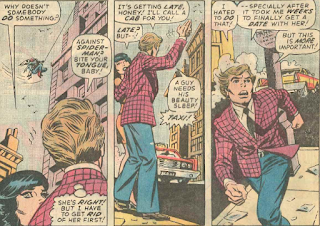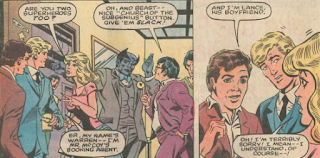Putting his X-Men days behind him, Bobby Drake began attending college at the University of California, Los Angeles. There, as Iceman, he became a founding member of the Champions.
Bobby updated his costume to make a stronger impression on his teammates, most notably new member Darkstar (Champions #14). The two heroes dated briefly until Darkstar abruptly decided to return to her homeland of Russia (#17).
After the Champions disbanded, Bobby met a woman named Teresa "Terri" Sue Bottoms and invited her to vacation with him at the summer home of Warren Worthington (who no longer hid his heroic identity as Angel). Terri was starstruck to meet the winged mutant, much to the chagrin of Warren's longtime girlfriend Candy Southern (Incredible Hulk Annual #7).
Bobby kept his own mutant powers secret from Terri Sue as they continued dating in Marvel Two-in-One #76 (June 1981). That same month, however, a guest appearance in Uncanny X-Men #146 (June 1981) revealed that Iceman had his eyes on someone else.
- Iceman: (Thinking) And to think I could be at school, romancing Sheila Delaney, the cute lady from the dorm next door.
Iceman had returned to the X-Men to help rescue Candy Southern and other friends and family of the mutant team who had been kidnapped by the assassin Arcade.
Uncanny X-Men #145, incidentally, had established that Bobby was now a college sophomore and attending school on the Eastern Seaboard.This panel from Uncanny X-Men #145 shows Iceman as a fan of the band KISS, whose members had crossed over into superhero comics.
Later, when almost every hero on Earth found themselves gathered together in Contest of Champions #1 (June 1982), Iceman took a moment to reconnect with Darkstar in one of the most touching scenes from that issue.
By this time, a theme had emerged in Bobby's love life. The women, like Darkstar, who knew he had mutant powers didn't want a lasting relationship with him, though for different reasons (Judy Harmon, Lorna Dane).










































































